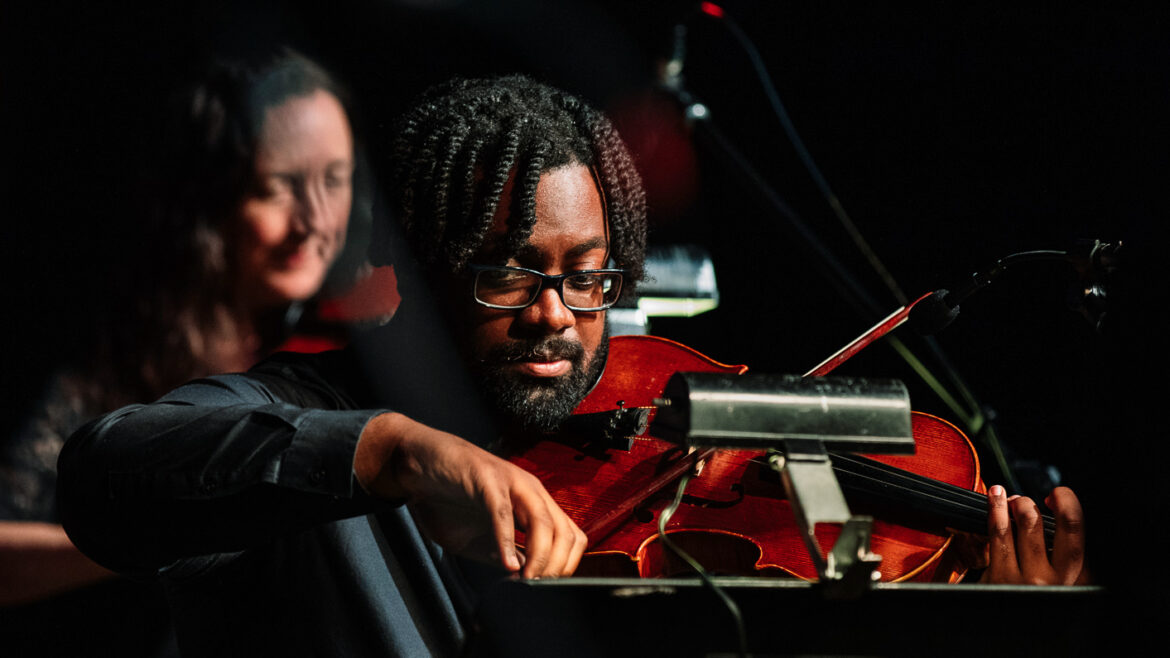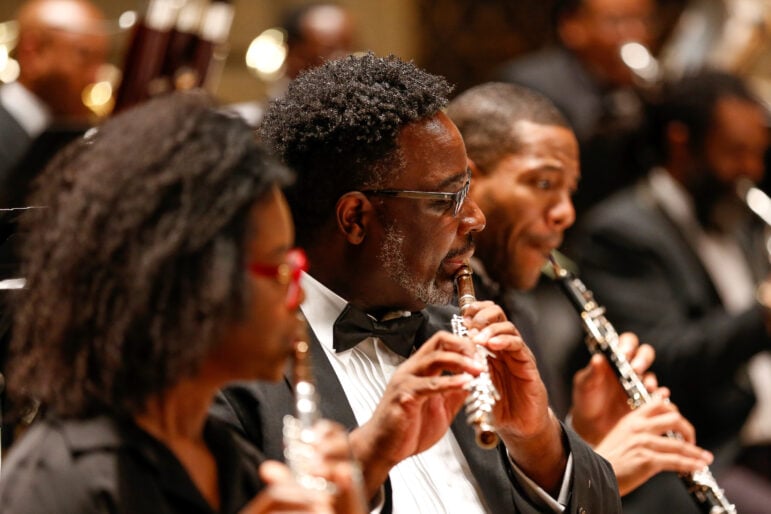Classical stations see audience, fundraising successes as listeners seek refuge during pandemic

Harris Jeeter
Violist Malik Johnson performs in a WDAV NoteWorthy concert at the Stage Door Theatre in Charlotte, N.C., June 25, 2021.
WDAV GM Frank Dominguez was eating lunch at his desk when he opened a monthly email report from the Radio Research Consortium, showing audience and listening statistics from January 2022.
“I had to look at it closely two or three times,” Dominguez said, laughing. “… I thought maybe they changed the format and things were being listed alphabetically.”
It wasn’t a mistake or a new format — for the first time ever, WDAV had reached number one in market share for the Charlotte market. Dominguez was stunned. Sure, they’d had some success in individual dayparts, and in a few years they’d gradually moved from number 18 to 20 in market share to number 10 or 12.
WDAV’s cume was pretty normal, around 100,000 listeners. The number one ranking was driven by time spent listening: a whopping 7 1/2 hours a week. “We’ve definitely been trending upward,” Dominguez said, “but nobody saw the number one coming.”
Like many stations, public radio’s classical outlets saw audience declines during the pandemic as people spent more time at home and less time in their cars. But by emphasizing long-held values of classical radio — to be soothing, to clear the mind, to remind people of aesthetic beauty — stations rose to the occasion to provide refuge from a world that felt scary and uncertain. That has translated into ratings records, strong fundraising and a reminder of the value of classical stations to local arts organizations.
“We heard from a significant number of listeners thanking us for being a place that was normal for them,” said Brenda Barnes, CEO of KING FM in Seattle. WDAV’s Dominguez and leaders at WXXI in Rochester, N.Y., and the USC Radio Group, which consists of KUSC in Los Angeles and KDFC in San Francisco, all said they heard the same from their listeners.
“[Listening to classical radio] is about choosing to be in a space for themselves, for their well-being, actually,” said USC Radio Group President Judy McAlpine. “We know during the pandemic that’s been a huge need.”
Providing a refuge and a helping hand
WDAV’s record share is an enormous achievement, said Abby Goldstein, president of the Public Radio Program Directors Association.
“For a noncommercial classical format, university-licensed public radio station to rank number one in their market … I don’t know that any classical station has ever achieved that level,” she said.
Goldstein observed that stations that leaned into connections with their communities appear to have better weathered the pandemic. Classical radio stations are often important local arts institutions, connecting symphonies, operas and ballets with audiences. As performances were canceled and arts organizations began to lose money, classical radio stations stepped up to help.
“There were concerts that actually were performed early in the pandemic, when things first shut down, by ensembles performing in empty halls,” said WXXI PD Ruth Phinney. “We were able to present some of those that people never got to [see].”
WXXI also reached out to ensembles and chamber groups around New York’s Finger Lakes region and asked for recordings of recent performances, then presented the music in a special 10-week series of 2-hour programs titled Performance Upstate.
Barnes said that among local arts institutions, classical radio stations were the “lucky ones.”
“We actually got to operate pretty much as normal, but the symphony, the opera, all of the large and small arts organizations were unable to do what they do, at all,” Barnes said. “So we worked with them to bring special programming to the station, to keep them front and center for listeners.”
While WDAV certainly has connections with Charlotte’s legacy arts institutions, it’s also made it a point to pop up in unexpected places.
“For a public radio station like WDAV that serves a niche market, we can’t rely on people just finding us on the dial,” said Will Keible, director of marketing and corporate support. Further, he said, classical music can be intimidating for some. “When you think about going to the Charlotte Symphony, you’ve got to dress up, and you don’t clap between movements, and there are all these rules, written or unwritten, that you’re expected to follow,” he said.
That’s part of why WDAV launched its Small Batch concert series, in collaboration with local brewery Free Range Brewing. The quarterly concerts feature local classical musicians and have drawn standing-room-only crowds to the brewery. “You just come as you are, have fun, drink a beer while you’re listening to classical music,” Keible said.
WDAV also collaborates with the Fair Play Music Equity Initiative on NoteWorthy, a concert series that pairs emerging local Black and brown artists with classically trained musicians.
“It’s about bringing people together from whatever backgrounds, but not necessarily focusing just on people who love classical music,” Dominguez said. “We want people who have an interest in classical music to use WDAV, to learn more about it. Maybe they’ll come to love it, but we want to make sure that the door’s open and everybody is feeling welcome.”
“Anything can happen in any one market. At the end of the day, WDAV has always been a leader in public radio as a classical station,” said Dave Sullivan, PPM client services manager with the Radio Research Consortium. “Stations need to be in the community to remind listeners of their value.”
Making everybody feel welcome is something WDAV has been working on for 25 years, said Dominguez.
“When I came to the station in 1994, we were so concerned about the fact that … like 50% of the audience was 65 or older,” said Frank Dominguez. He said it was around the same time that WDAV station leaders first took a hard look at audience data and started asking themselves, “What do our listeners want?”
It was a new way of thinking about classical music, and it just may have saved the industry from certain doom, as commercial classical stations increasingly switched formats and many public stations eschewed classical music in favor of news.
“Everybody thought that classical music was dying and classical radio is dying … ‘no one cares, the audience is old and aging,’” said Brenda Barnes. “That’s not true.”
The stations that survived were those who evolved and adapted to new realities and new audiences. In the fall of 1999, KDFC topped the Bay Area charts. Then-PD Bill Lueth told the San Francisco Chronicle, “We’ve tried to program this station for the way people actually listen to radio, rather than what someone thinks is good for you. And the result is that we’ve watched the station grow and grow.”
But it’s recently become clear to many station leaders just how much work is left to do in making everyone feel welcome.
“I’d say really just in the last five years have we become more aware that we need to define classical music not as this European, white, predominantly male art form,” said WDAV Content Director Rachel Stewart.
Integrating music by composers like Florence Price, William Grant Still and Coleridge-Taylor Perkins into playlists has only improved on-air programming, said Dominguez.

“We are changing our library and our rotation cycles so that … you’re hearing representation from all different composers and performers all the time,” said WXXI’s Ruth Phinney. The station also profiles classical musicians of African descent on its website. “We’ve actually had classical musicians contact us and say, ‘I’m a classical musician, I’m not on your site yet. Can you put me on there?’”
Growing into the future
The strategies of inclusion and expansion appear to be working for these stations. Dominguez reports that a quarter of WDAV’s audience is between the ages of 18–34 and said the station had some of its strongest fundraisers in history during the pandemic. WDAV has seen increased underwriting revenue as a result of the January book, Keible said.
“Obviously what led to the number one is the time spent listening … because there are other stations with bigger weekly cumes,” said Dominguez. “I think our people genuinely like to spend time with us. Not only because the listening is good, but because they feel like we’re friends, we’re really good people to be with.”
WXXI, KUSC, KDFC and KING also reported strong fundraising from a variety of sources, whether through membership, philanthropic support or other means.
Phinney said WXXI’s first pandemic drive in October 2020 was wildly successful. “We hardly had to open our mouths and people just called. … All we had to do was say, ‘We’ve been here for you.’”
KING had a similar experience. “People really felt the value of the station to a greater degree during the pandemic and wanted to make certain that the station had the funding it needed to not just survive but thrive,” said Barnes.
KING and KDFC both moved into new facilities during the pandemic after successful capital campaigns. And stations are experimenting with new ways of connecting with audiences digitally beyond just streaming. Sometimes it’s as simple as putting a playlist on Spotify, says WDAV’s Will Keible.
“I got some funny looks from peers across the public media network,” Keible said. “But I think you’ve got to be there. You might as well put your brand out in those areas.”
Or it could mean a more substantial investment in areas such as social media and video.
“One of the reasons we’re building out our digital platforms is because we believe on YouTube, on Instagram, et cetera, that people will bump into what we are doing who are in different demographics,” said Judy McAlpine at KUSC and KDFC. “We’re hoping they’ll be delighted and interested in what we’ve got there.”
Station leaders agree that classical radio’s biggest challenge now is identifying and developing new talent.
“If you look around at the industry, it’s an aging industry and an overwhelmingly white industry,” Dominguez said. “We really have to, in earnest, reach out to younger generations and more diverse generations to make sure that they consider this as a career option.”
Correction: An earlier version of this article incorrectly referred to Judy McAlpine as president of KUSC and KDFC. She is president of the USC Radio Group, which includes both stations.





